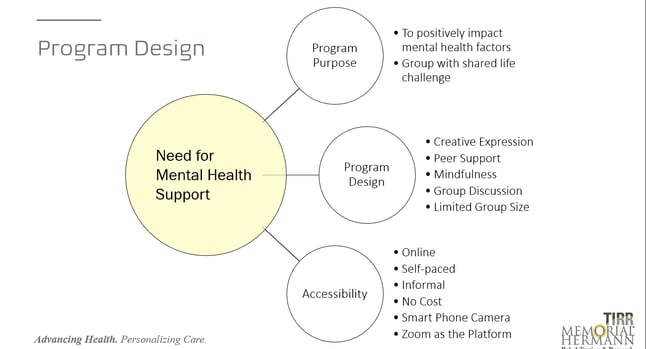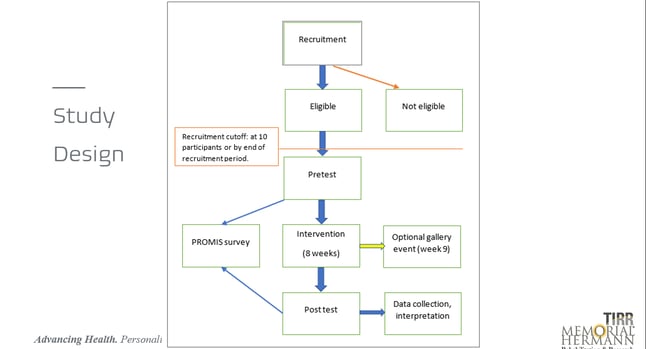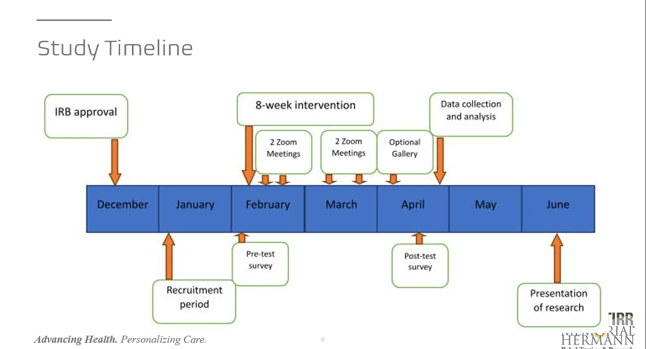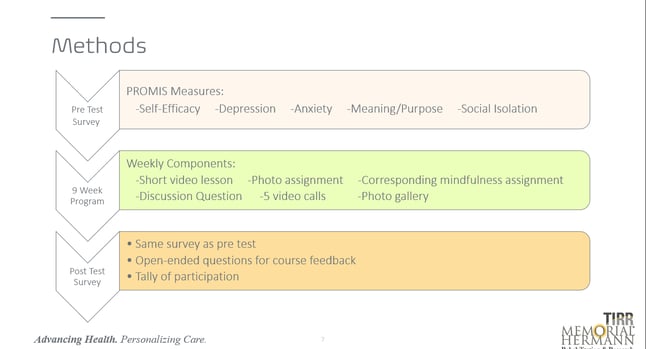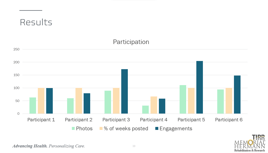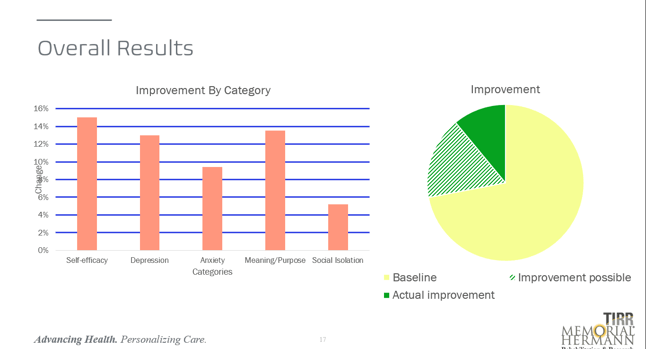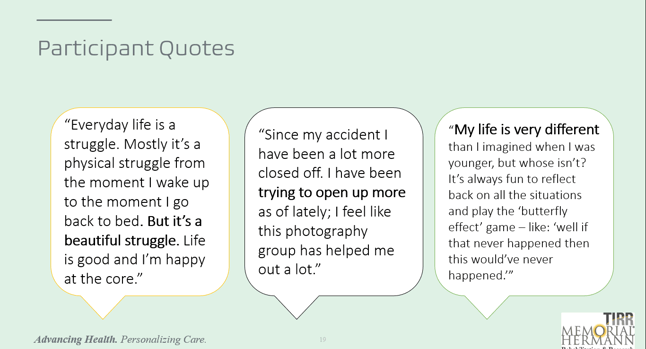New Lens Therapeutic Photography Program: A Pilot Study
The following research study on the New Lens Therapeutic Photography Program was conducted by Caroline Mrowiec as a requirement for successfully completing Memorial Hermann's neurologic occupational therapy fellowship, June 2022.
Caroline Mrowiec, OTR/L, neurologic fellow, Memorial Hermann
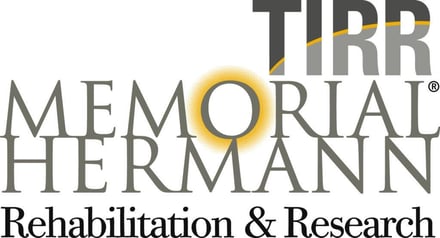

Purpose:
The purpose of this study is to investigate the feasibility and effectiveness of an online, nine-week, therapeutic photography program to reduce anxiety, depression, and social isolation and improve self-efficacy and sense of meaningfulness and purpose with adults with chronic spinal cord injury.
The aim of this study is to investigate the feasibility and effects of an online, nine-week, therapeutic photography program.
The second aim is to investigate if the therapeutic photography program improves mental health factors measured by PROMIS survey responses.
The first hypothesis is that participants will participate in the weekly activities at least 75% of the time. The second hypothesis is that PROMIS survey responses on mental health factors will improve from pre-test to post-test.
Introduction:
People with spinal cord injury (SCI) are at an increased risk for anxiety, depression, and social isolation (Hearn, 2020). According to a systematic review, having psychological resources were associated with a positive adjustment to SCI and improved mental health, however, further development of psychological resource-based interventions is needed (Peter et al., 2012).
Research supports that, interventions such as mindfulness, therapeutic photography, and group intervention via an online platform have been shown to help individuals with symptoms of anxiety, depression, and increase self-efficacy. (Fuchs et al., 2013, Saita, E., & Tramontano, M., 2018, Hearn, J.H., Cross, A., 2020). Therapeutic photography can be defined as an intervention using photo-based activities done individually or as part of a group for therapeutic benefits but without any formal psychotherapy (Saita & Tramontano, 2018). Mindfulness can be defined as a mental state achieved by focusing one's awareness on the present moment, while calmly acknowledging and accepting one's feelings, thoughts, and bodily sensations, used as a therapeutic technique (Grossman, 2015).
Programs for mindfulness have been created and implemented with groups of people facing a similar life challenge, however, studies show that participants face a variety of barriers when it comes to being able to engage and follow through to the end of a program (Lehto & Wyatt, 2013, and Toivonen et al., 2020).
Although psychological resources that improve mental health such as mindfulness and therapeutic photography can improve the well-being of people with SCI, such resources are limited and not widely accessible.
Program Design:
Study Design:
Eligibility requirements: 18 years or older, English-speaking, at least 3 months s/p SCI (any level), access to a smartphone (any model). PROMIS survey: 20 survey questions, 5 categories, 4 questions in each category- done through Google Forms. PROMIS measures are both valid and reliable measures.
Study Timeline:
Methods:
Results:
Overall: No participants dropped out of the program and all the participants reported having a positive experience doing the program with no negative effects. All the participants completed all the assignments for each week except for one participant who missed four assignments. The video calls were well attended by all participants, and all the participants engaged in group text discussions and commented on each other’s photos. Some participants were significantly more active in the group chats than other members. Only one participant did not attend the gallery event due to being ill, however, was able to video call into the event for part of the time.
There may be correlations between demographic information and participants’ scores (age, gender, marital status, years injured), however, this information could not be generalized due to the limited number of participants. Since all the participants had spinal cord injuries at grossly the same level (cervical spine C5-C8), the scores cannot be used to make comparisons or draw conclusions for other levels of spinal cord injury. There did not seem to be a correlation between the number of engagements and the improvement in scores.
Overall Participant Results:
The participants who had the highest margin for improvement were also the participants who were the least engaged in the program. The participant who had the smallest margin for improvement was the most engaged participant. Stronger coping skills and confidence at baseline seemed to influence the level of engagement of the participants, but even the participants who were less engaged were still able to improve their scores. The two categories that showed a positive change with all the participants with significant improvement possible were the categories of “self-efficacy” and “meaning and purpose.” This could indicate that the program’s benefits were best captured by these two outcome measures.
Discussion:
No participants dropped out of the program and all the participants reported having a positive experience doing the program with no negative effects. All the participants completed all the assignments for each week except for one participant who missed four assignments.
The video calls were well attended by all participants, and all the participants engaged in group text discussions and commented on each other’s photos. Some participants were significantly more active in the group chats than other members. Only one participant did not attend the gallery event due to being ill, however, was able to video call into the event for part of the time.
There may be correlations between demographic information and participants’ scores (age, gender, marital status, years injured), however, this information could not be generalized due to the limited number of participants. Since all the participants had spinal cord injuries at grossly the same level (cervical spine C5-C8), the scores cannot be used to make comparisons or draw conclusions for other levels of spinal cord injury. There did not seem to be a correlation between the number of engagements and the improvement in scores. (in the first group, there was a correlation for participants who did not post or participate much, so there is room for variation in participation but must have some).
The participants who had the highest margin for improvement were also the participants who were the least engaged in the program. The participant who had the smallest margin for improvement was the most engaged participant. Stronger coping skills and confidence at baseline seemed to influence the level of engagement of the participants, but even the participants who were less engaged were still able to improve their scores. The two categories that showed a positive change with all the participants with significant change possible were the categories of “self-efficacy” and “meaning and purpose.” This could indicate that the program’s benefits were best captured by these two outcome measures. Self-efficacy was used in the first group and this showed the most positive change as well.
Participant Quotes:
